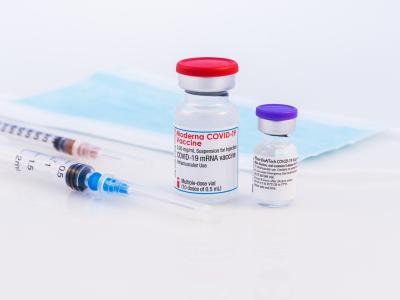Oct 8, 2010
NIH funds vaccines against anthrax, dengue
The National Institute of Allergy and Infectious Diseases (NIAID) yesterday announced three new contracts worth up to $68 million to fund research on vaccines to protect against anthrax and dengue fever. The NIAID is part of the National Institutes of Health (NIH). The three studies will focus on a needle-free dengue vaccine, an oral anthrax vaccine, and an injectable anthrax vaccine with an immune-boosting adjuvant. PaxVax Inc. of San Diego will develop and test two formulations of the oral anthrax vaccine, both of which contain a gene that codes for a protein that protected animals from anthrax in previous studies. Emergent Biosolutions of Rockville, Md., will develop and test an anthrax vaccine consisting of Emergent's licensed injectable anthrax vaccine, BioThrax, combined with an adjuvant. The dengue vaccine is being developed by Inviragen Inc. of Fort Collins, Colo. It's a tetravalent vaccine, for protection against the four related viruses that cause dengue fever. If milestones are reached, the three contracts could total $68 million. "These new contracts build on NIAID's commitment to support the advanced development of products that are important to the public health but often unattractive to investors in private industry," said NIAID Director Anthony S. Fauci, MD, in a press release.
Oct 7 NIH press release
BioWatch program gets lukewarm report card
The BioWatch system, launched in 2003 by the Department of Homeland Security (DHS) to speed detection of biological attacks through air samplers in selected cities, received a lukewarm rating in a report yesterday. Written by a committee convened in 2008 by the Institute of Medicine (IOM) and the National Research Council at the direction of Congress, the report raises several issues about the management and priorities of the system and about its technical performance. Specific suggestions to DHS for program enhancement include: (1) strengthening the relationship between BioWatch and the state and local jurisdictions in which it operates so local officials can better interpret and respond to positive signals from air samplers as well as reimbursing the localities, (2) conducting systematic testing and evaluation of current and planned technology to bring it up to date, (3) pursuing opportunities to advance future biodetection systems, and (4) making BioWatch planning risk-based and responsive to user needs. The report also makes recommendations for actions by the federal government and others aimed at improving both infectious disease surveillance in general and the analysis and exchange of information in the public health and healthcare sectors.
Oct 7 IOM report [abbreviated version]
IOM page with links to report brief, congressional testimony, and full report
WHO keeps same strains for 2011 Southern Hemisphere flu vaccine
The World Health Organization (WHO) has again recommended the 2009 H1N1 strain as a component of the Southern Hemisphere's next seasonal flu vaccine, a sign that it expects the virus to circulate there during that region's flu season, which typically starts in May. It its Weekly Epidemiologic Record (WER) today, the WHO also recommended keeping the other two strains the same as for next year's Southern Hemisphere vaccine: an influenza A (H3N2) Perth-like virus and an influenza B Brisbane-like virus. The three strains are also the same for this season's Northern Hemisphere vaccine. The WHO's technical consultants meet in September each year to analyze global flu circulation data and recommend strains for the next Southern Hemisphere flu season. They do the same for the Northern Hemisphere in February.
WHO confirms 40,000 cholera cases in central Africa
The WHO announced today that a cholera outbreak that started a few months ago in central Africa has affected at least 40,468 people, 1,879 of whom have died. By far the heaviest hit country is Nigeria. The WHO said the rainy season and related flooding, poor hygienic conditions, and population movements have all contributed to the unusually high incidence. The agency is providing technical and surveillance support in the region. The number of cases and deaths in the four affected countries breaks down as follows: Cameroon, 7,869 cases, 515 deaths, case-fatality rate (CFR) 6.5%; Chad, 2,508 cases, 111 deaths, CFR 4.4%; Niger, 976 cases, 62 deaths, CFR 6.4%; Nigeria, 29,115 cases, 1,191 deaths, CFR 4.1%.
Oct 7 WHO report
Southern China experiences chikungunya outbreak
Officials have confirmed at least 10 cases of chikungunya, a mosquito-borne disease, in the southern industrial city of Dongguan in Guangdong province, according to Xinhua News, China's state news agency. Provincial health officials said 10 of 15 blood samples tested positive for the virus but also announced 76 suspected cases pending test results. The chikungunya virus, which causes fever, joint pain, and rash, is carried predominantly by the Aedes aegypti, or yellow fever, mosquito. Most infections occur in tropical Africa and Southeast Asia.
Oct 4 Xinhua story


















